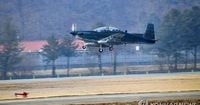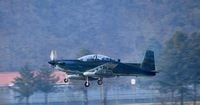On April 19, 2025, a South Korean Air Force KA-1 aircraft experienced a significant incident during a night training flight over Pyeongchang County, located approximately 125 kilometers east of Seoul. The aircraft lost two gun pods and two empty fuel tanks, which fell into a mountainous area, leading to concerns about safety and operational protocols.
According to the South Korean Air Force, the dropped components landed in a forested region, and fortunately, there were no reported civilian casualties. In response to the incident, the Air Force has established an investigation committee led by the Deputy Chief of Staff to determine the exact cause of the mishap.
The KA-1 is a light attack and reconnaissance aircraft manufactured by Korea Aerospace Industries (KAI) in collaboration with the South Korean Defense Development Agency (ADD). This aircraft has been in production since the early 2000s and is based on the KAI KT-1 trainer aircraft. With a length of 10.3 meters, a wingspan of 10.6 meters, and a height of 3.7 meters, the KA-1 is designed for various military operations.
Equipped with a Pratt & Whitney Canada PT6A-62 engine, the KA-1 boasts nearly 950 horsepower, allowing it to reach a maximum speed of 648 kilometers per hour. It has a maximum range of 1,300 kilometers and can operate at a ceiling of 11,600 meters. The aircraft is capable of carrying a range of weapons, including machine guns, air-to-ground missiles, conventional bombs, and smart bombs. Furthermore, it is fitted with modern communication systems, reconnaissance capabilities, and target designation technologies, making it a versatile asset for ground support and tactical reconnaissance.
In light of the incident, experts have raised questions about the operational safety protocols in place for the KA-1, particularly during night training exercises. The South Korean Air Force has emphasized its commitment to safety and operational excellence, stating, "The parts that fell from the aircraft have been confirmed to have landed in a mountainous area, and we affirm that there were no civilian casualties in this incident." This reassurance aims to quell public concern and maintain confidence in the military's operational integrity.
The KA-1's design allows for five weapon hardpoints, with two located on each wing and one on the fuselage. These hardpoints can accommodate various armaments, including LAU-131 rocket launchers or HMP machine guns that utilize 12.7mm ammunition. This flexibility in armament options further enhances the KA-1's role as a light attack aircraft.
As the investigation progresses, the South Korean military is expected to review its training protocols and safety measures to prevent similar incidents in the future. The KA-1 aircraft, which has been praised for its capabilities in ground support and pilot training, faces scrutiny following this incident, prompting discussions about the importance of rigorous safety standards in military aviation.
Moreover, the incident has sparked a broader conversation about the readiness and safety of military operations in South Korea, especially as tensions in the region continue to fluctuate. The South Korean government has reiterated its commitment to maintaining a robust defense posture while ensuring the safety of both military personnel and civilians.
In conclusion, the loss of equipment from the KA-1 aircraft during a routine training flight raises important questions about military aviation safety and operational protocols. With an investigation underway, the South Korean Air Force aims to address these concerns and reinforce its commitment to maintaining high safety standards in its operations.





